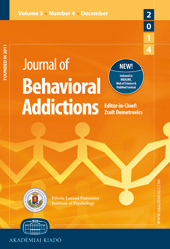The invisible addiction: Cell-phone activities and addiction among male and female college students
The invisible addiction: Cell-phone activities and addiction among male and female college students
Author(s): James A. Roberts, Luc Honore Petnji Yaya, Chris ManolisSubject(s): Gender Studies, Psychology, Higher Education , Behaviorism, Substance abuse and addiction, Health and medicine and law, ICT Information and Communications Technologies
Published by: Akadémiai Kiadó
Keywords: cell-phones; addiction; gender; technology;
Summary/Abstract: The primary objective of the present study was to investigate which cell-phone activities are associated with cell-phone addiction. No research to date has studied the full-range of cell-phone activities, and their relationship to cell-phone addiction, across male and female cell-phone users. Methods: College undergraduates (N = 164) participated in an online survey. Participants completed the questionnaire as part of their class requirements. The questionnaire took 10 and 15 minutes to complete and contained a measure of cell-phone addiction and questions that asked how much time participants spent daily on 24 cell-phone activities. Results: Findings revealed cell-phone activities that are associated significantly with cell-phone addiction (e.g., Instagram, Pinterest), as well as activities that one might logically assume would be associated with this form of addiction but are not (e.g., Internet use and Gaming). Cell-phone activities that drive cell-phone addiction (CPA) were found to vary considerably across male and female cell-phone users. Although a strong social component drove CPA for both males and females, the specific activities associated with CPA differed markedly. Conclusions: CPA amongst the total sample is largely driven by a desire to connect socially. The activities found to be associated with CPA, however, differed across the sexes. As the functionality of cell-phones continues to expand, addiction to this seemingly indispensable piece of technology becomes an increasingly realistic possibility. Future research must identify the activities that push cell-phone use beyond its “tipping point” where it crosses the line from a helpful tool to one that undermines our personal well-being and that of others.
Journal: Journal of Behavioral Addictions
- Issue Year: 3/2014
- Issue No: 4
- Page Range: 254-265
- Page Count: 12
- Language: English

